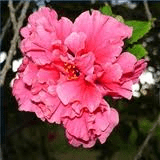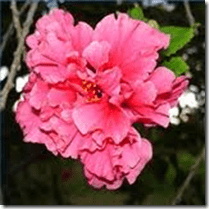The double bloom hibiscus is a tropical plant that is known for its showy, fragrant flowers. Adapted to hot and humid climates, the double bloom hibiscus can be enjoyed year-round by those who live in USDA hardiness zones 9 and 10. In cooler climates, gardeners can use tropical hibiscus plants as annuals, enjoying the bright blossoms throughout the summer and allowing the plant to die once winter arrives. Alternatively, northern gardeners can opt to plant their hibiscus in containers and winterize them, extending the plant’s life indefinitely.
Difficulty: Moderately Easy
Instructions
Things You’ll Need:
- Pruning shears
- 1 tsp. mild dishwashing soap
- 2 cups warm water
- Plastic spray bottle
- Baby wipes
- Fluorescent lamp
-
Examine the hibiscus plant every day beginning in early autumn. Pluck any brown leaves or spent blossoms from the branches.
-
Cut away any dead, damaged or deformed stems with sharp pruning shears in the late autumn, prior to the arrival of the first frost. Trim the hibiscus back, cutting the branches which extend from the plant’s main trunk in half. The main trunk can be cut down as well, if desired, removing up to 50 percent of the plant material and reducing the overall height of the tree.
-
Monitor the temperature. When the overnight temperature is expected to reach 45 degrees Fahrenheit or less, it is time to move the hibiscus indoors. Exposure to temperatures this low will damage and could possibly kill the plant.
-
Wash the plant to remove any dirt, debris or pests that may be hiding in the remaining foliage. Pour 1 tsp. of mild dishwashing soap and 2 cups of warm water into a plastic spray bottle and shake vigorously to blend. Spray the soap solution onto the plant and then set the plant in a warm location and allow it to dry. Wipe the foliage with a warmed baby wipe to remove the soap residue.
-
Move the hibiscus to a cool but controlled climate such as an enclosed porch, shed, garage or basement. Place the plant near a window, if possible, so that the remaining foliage will receive natural sunlight. If no window is available, the plant will need artificial light. Suspend a fluorescent lamp approximately 5 feet above the hibiscus. Leave the lamp on for four to six hours per day for the duration of the winter.
-
Water the hibiscus deeply and then wait two to three weeks before adding more water, allowing the soil to become very dry in the intermission. According to the University of Illinois, this will keep the plant alive without encouraging the growth of new tissues. Additionally, it helps to prevent the development of mold and fungus in the potting soil. If your hibiscus is exposed to artificial heat, additional humidity may be necessary to ensure the health of the plant. Mist the plant liberally with water two to three times a week to add moisture, if needed.
Tips & Warnings
-
Do not be alarmed when the remaining hibiscus leaves turn yellow and drop to the ground. This signals the arrival of the dormancy period — a natural part of the plant’s life cycle. It in no way indicates a problem with the plant.


Deprecated: strpos(): Passing null to parameter #1 ($haystack) of type string is deprecated in /home/agriviek8Qv/agriviet.net/public_html/wp-includes/comment-template.php on line 2522